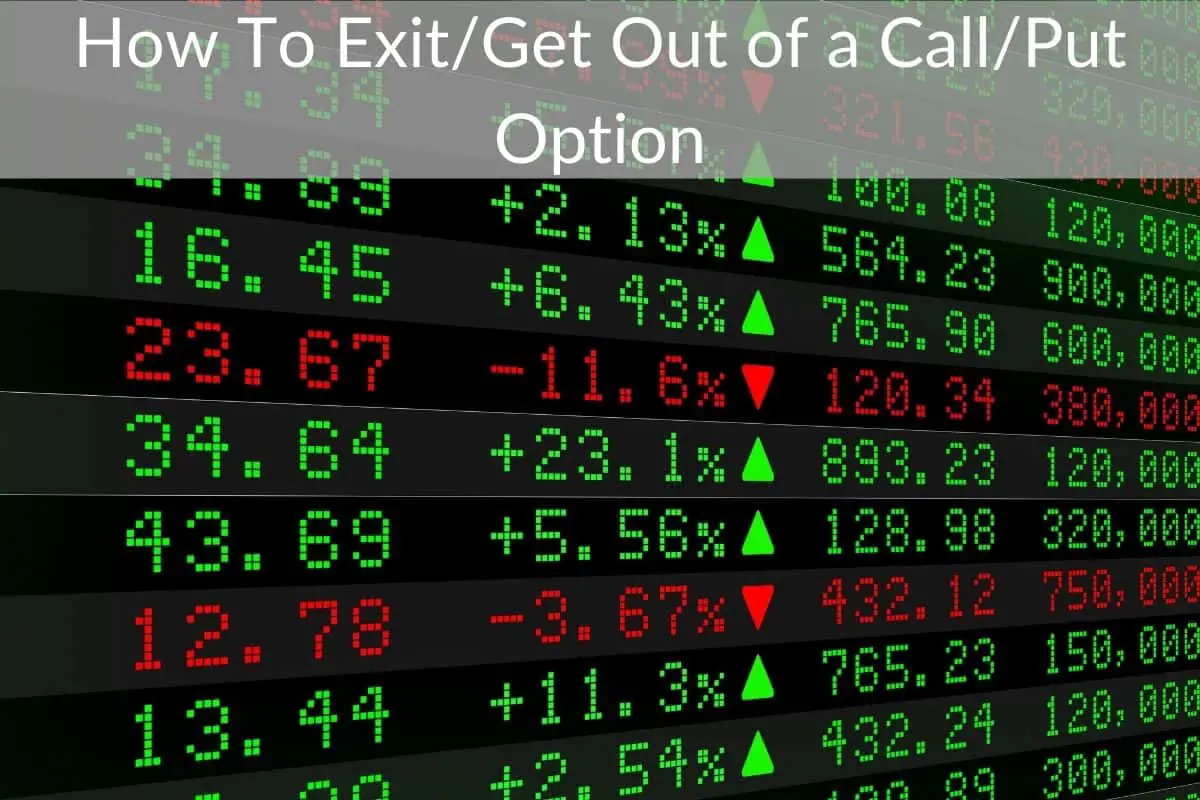Table of Contents
*This post may contain affiliate links. As an Amazon Associate we earn from qualifying purchases.
You establish an open position when you sell a call option, whether covered or uncovered or when you buy it. Although each option has its own buyer and seller, there is no mechanism for buying back the original option sold.
You can, however, enter into a closing transaction to terminate your position.
There are three ways to close an options trade:
- Sell/buy to close.
- Let the contract expire.
- Exercise the contract.
The decision to sell/buy, let expire, or exercise is based largely on your risk tolerance and financial goals for establishing each position. In general, you should always trade with an exit strategy in mind.
Selling or buying to close is determined by whether you sold or bought a call/put option in the first place. For example if you bought a call option you would then sell to close it. However if you sold a call option you would then buy to close to end that position.
In the rest of this article, we’ll look at the options you have for closing your options trade.
1. Sell/buy To Close
To sell a contract is to terminate the position by selling the contract that you previously purchased (whether it is a put or cal doesn’t matter). You can also buy to close if originally you were the seller of a put or call option.
In options trading, contracts are bought and maintained for either short or long positions. Once a trader has acquired a contract, they can only deal with it in three ways:
- It’s out of the money (OTM) and has no value after a certain period;
- (ITM) or in the money options can be exercised or settled for the underlying difference; or
- The option can be sold to close the position. An option sell order may be placed at any of the three strike prices, and it can be OTM, ITM, or ATM (at the money).
Three things may happen when selling to close a call or put position:
Sell To Close for a Profit
If the underlying asset’s price rises more than enough to compensate for time decay (the closer it gets to expiration), the call option’s value will also rise.
A trader may profitably sell a long call option if its value increases as a result of this.
Sell To Close at Break-Even
If the underlying asset price rises only enough to offset the time decay, then the value of the call option will not change. In this situation, a trader can sell to break-even to close a long call option.
Sell To Close for a Loss
If the underlying asset’s price does not rise enough to compensate for time decay, the option’s value will fall. In this case, a trader may sell out of the long call option at a loss in order to close it.
Have a Trade Strategy in Place
Before you enter an options trade, you should have a trading strategy in place. But what exactly does it imply?
A trade plan is a method for determining your exit strategy for every trade you start. If you have a trade plan in place, you’re less likely to be affected by market changes after making the deal or at least will know what you should do.
If you know why you bought the option contract in the first place you can then sell that position when that reason is no longer valid. That will help you sell the call/put rather than holding it to expiration and hoping that it goes up in value.
2. Let the Contract Expire
The last day that a derivative, such as an option or a future, is valid is its expiration date. Investors should have already determined what to do with their expiring position before this date.
Expiration dates are typically the third Friday of every month for standardized options contracts. There are, however, weekly options contracts that expire every Friday.
What happens to your option position depends on two things:
Long or Short Option
When you have a “long” position in a security, it means that you are the owner of the security.
A “short” position is generally the sale of a stock which you do not own. Investors who sell short expect the price of the stock to drop. If the price drops, you may buy the stock at a lower price and make money.
In-the-Money (ITM) or Out-of-the-Money (OTM)
An ITM option is one in which the current stock price has already exceeded the strike price.
An OTM option is one with a strike price that the underlying security hasn’t yet achieved, so there’s no inherent value.
Options are divided into two categories: calls and puts. The holder of a call option has the right, but not the obligation, to purchase a stock at a specific strike price by the expiration date if it reaches that price.
If a stock reaches a particular strike price by the expiration date, the owner of a put option has the right, but not the obligation, to sell it or exercise it (which I will go over next).
3. Exercise the Contract
The term “to exercise” in options trading refers to putting the option contract into effect. To exercise an option, you must notify your broker that you wish to do so.
If a put option is exercised, the underlying security will be sold at a specified price within a designated time frame. If the owner of a call option exercises the contract, they will purchase the underlying asset at a stated price within a specific duration.
When considering whether or not to exercise a specific option, consider what sort of option you have and whether you can use it.
To Exercise a Put Option
An investor who purchased a put option has the right, but not the obligation, to sell the stock at the strike price. The owner may either sell the put option to another buyer before it expires for a fair market value price or convert it into an outright sale by selling the stock at its market value.
To Exercise a Call Option
The order to execute your options is determined by the position you’re in. If you bought call options to open, for example, you would follow the same procedure as outlined above: contact your brokerage firm and provide instructions to exercise the call options (to purchase the underlying stock at the strike price).
Final Thoughts
There are three ways to close an options trade, and the different methods will depend on your goals for the contract. If you want to lock in profits or protect against losses, selling is a good option.
For hedgers who want to reduce their risk exposure, letting the contract expire may be best. Contract holders can also exercise them if they think that prices are going up before the expiration date arrives.
The most common way to close a trade is by selling or buying it to close. If you’re not sure what the best course of action is, consult with your broker or financial advisor before making any decisions.

